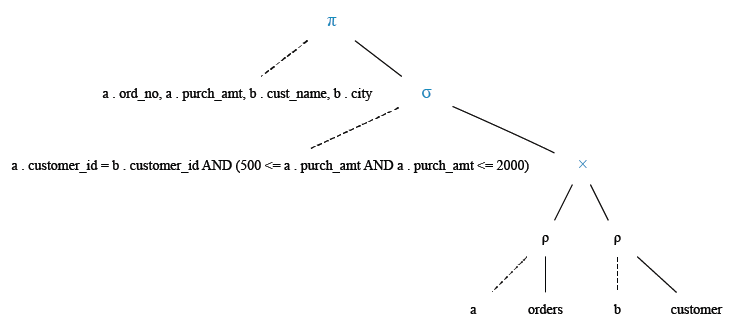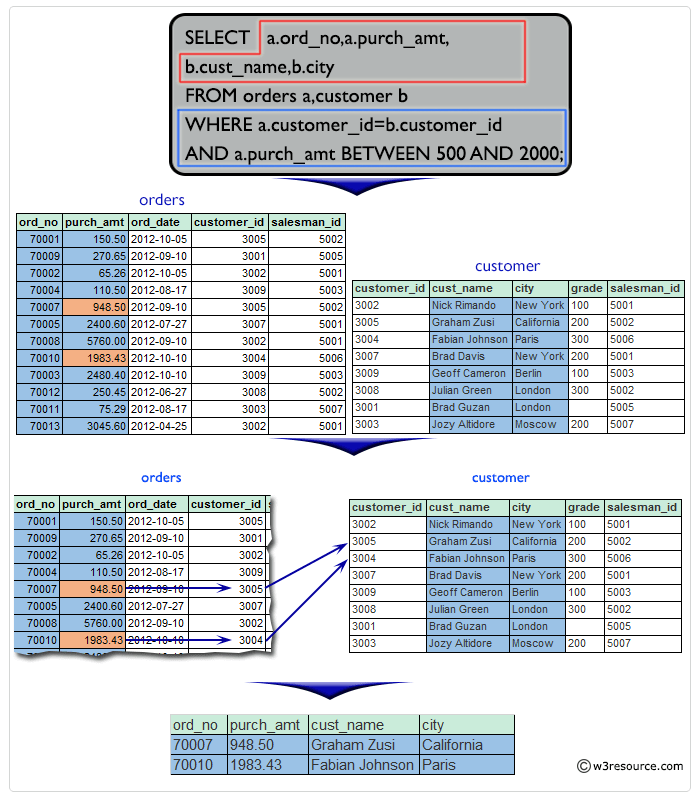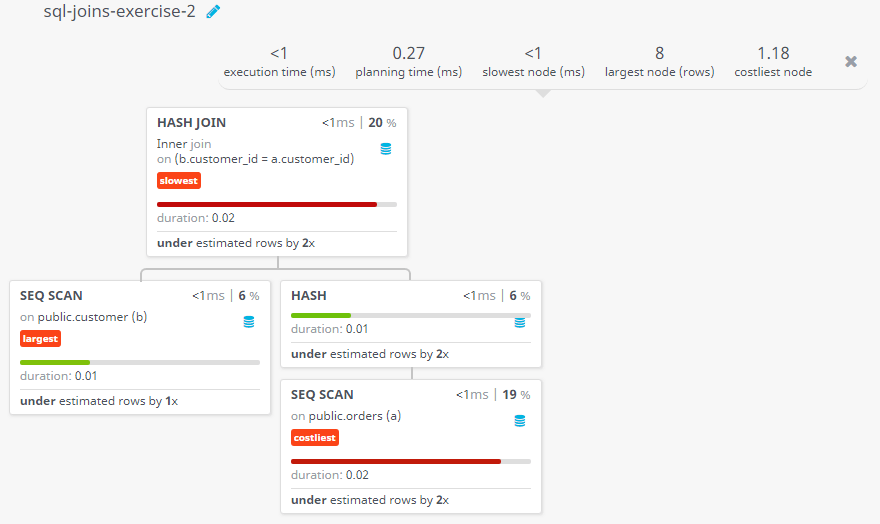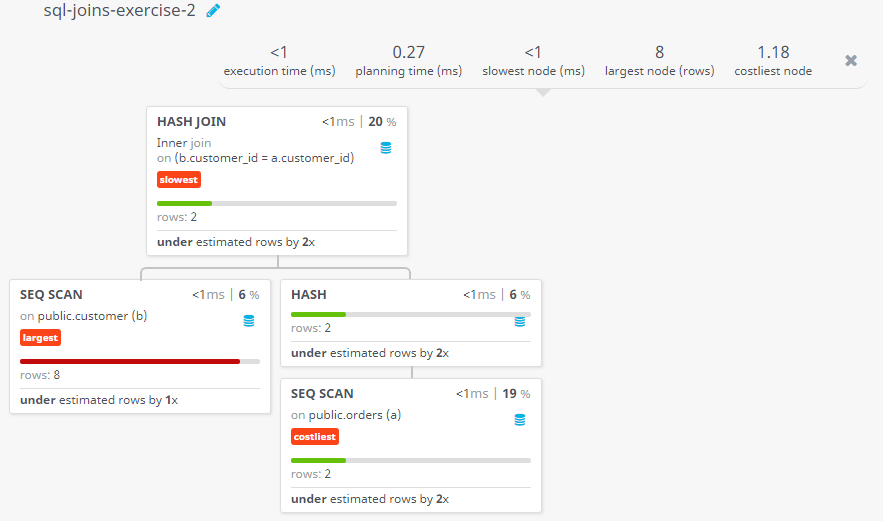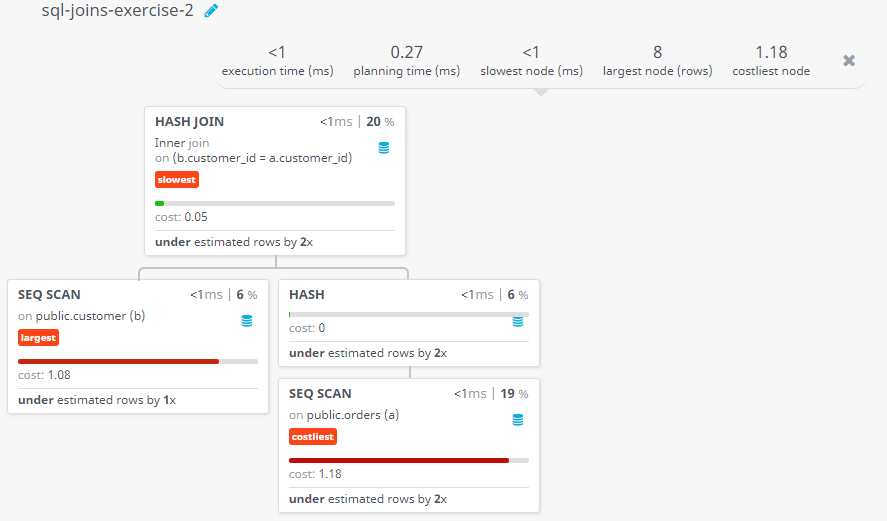SQL Exercise: Customers and their cities for given range of orders
2. Orders in Amount Range
From the following tables write a SQL query to find those orders where the order amount exists between 500 and 2000. Return ord_no, purch_amt, cust_name, city.
Sample table: customer
customer_id | cust_name | city | grade | salesman_id
-------------+----------------+------------+-------+-------------
3002 | Nick Rimando | New York | 100 | 5001
3007 | Brad Davis | New York | 200 | 5001
3005 | Graham Zusi | California | 200 | 5002
3008 | Julian Green | London | 300 | 5002
3004 | Fabian Johnson | Paris | 300 | 5006
3009 | Geoff Cameron | Berlin | 100 | 5003
3003 | Jozy Altidor | Moscow | 200 | 5007
3001 | Brad Guzan | London | | 5005
Sample table: orders
ord_no purch_amt ord_date customer_id salesman_id ---------- ---------- ---------- ----------- ----------- 70001 150.5 2012-10-05 3005 5002 70009 270.65 2012-09-10 3001 5005 70002 65.26 2012-10-05 3002 5001 70004 110.5 2012-08-17 3009 5003 70007 948.5 2012-09-10 3005 5002 70005 2400.6 2012-07-27 3007 5001 70008 5760 2012-09-10 3002 5001 70010 1983.43 2012-10-10 3004 5006 70003 2480.4 2012-10-10 3009 5003 70012 250.45 2012-06-27 3008 5002 70011 75.29 2012-08-17 3003 5007 70013 3045.6 2012-04-25 3002 5001
Sample Solution:
-- Selecting specific columns from the 'orders' and 'customer' tables
SELECT a.ord_no, a.purch_amt,
b.cust_name, b.city
-- Specifying the tables to retrieve data from ('orders' as 'a' and 'customer' as 'b')
FROM orders a, customer b
-- Specifying the condition for joining the tables based on customer_id
WHERE a.customer_id = b.customer_id
-- Filtering the results based on the purchase amount between 500 and 2000
AND a.purch_amt BETWEEN 500 AND 2000;
Output of the Query:
ord_no purch_amt cust_name city 70007 948.50 Graham Zusi California 70010 1983.43 Fabian Johnson Paris
Explanation:
The said SQL query is selecting the order number, purchase amount, customer name and customer city from the "orders" table as alias a and "customer" table as alias b, and only displaying results where the customer ID of the "orders" table matches the customer ID of the "customer" table and the purchase amount is between 500 and 2000.
Relational Algebra Expression:
Relational Algebra Tree:
Explanation:
Visual Explanation:
PREV : Salesmen and customer, who belongs to same city.
NEXT : A list of which salesmen work for which customers.
Practice Online
Query Visualization:
Duration:
Rows:
Cost:
For more Practice: Solve these Related Problems:
- Write a SQL query to retrieve order number, purchase amount, customer name, and city for orders with purchase amounts between 500 and 2000, ordering the results by purchase amount.
- Write a SQL query to list orders within the 500–2000 range, excluding orders placed on weekends.
- Write a SQL query to select orders where the purchase amount is between 500 and 2000 and include a computed column showing how much is needed to reach 2000.
- Write a SQL query to display order details for orders with amounts between 500 and 2000, but only for customers located in major metropolitan areas.
Have another way to solve this solution? Contribute your code (and comments) through Disqus.
What is the difficulty level of this exercise?
Test your Programming skills with w3resource's quiz.


